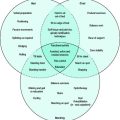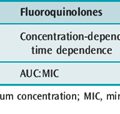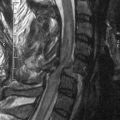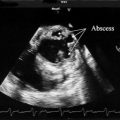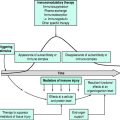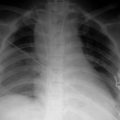Chapter 49 Neuromuscular disorders in intensive care
A number of disorders producing generalised neuromuscular weakness can require admission to the intensive care unit (ICU), or complicate the course of ICU patients. These may involve:
Table 49.1 lists a differential diagnosis of muscle weakness in critically ill patients.
Table 49.1 Differential diagnosis of muscle weakness in critically ill patients
| Cerebral cortex |
| Vascular event |
| Metabolic or ischaemic encephalopathy |
| Brainstem |
| Lower pontine hemorrhage or infarction (locked-in state) |
| Spinal cord |
| Transverse myelitis |
| Compression by tumour, abscess or hemorrhage |
| Carcinomatous or lymphomatous meningitis |
| Peripheral nerve |
| Critical-illness polyneuropathy |
| Phrenic nerve injury during thoracic surgery |
| Guillain–Barré syndrome |
| Ingested toxins, including arsenic, thallium, cyanide |
| Neuromuscular junction |
| Delayed reversal of neuromuscular blockade |
| Myasthenia gravis |
| Lambert–Eaton syndrome |
| Botulism |
| Pesticide poisoning |
| Skeletal muscle |
| Acute necrotising myopathy |
| Steroid myopathy |
| Severe hypokalaemia, hypophosphataemia and/or hypomagnesaemia |
| Acute alcoholic myopathy |
| Polymyositis or dermatomyositis |
| Toxic myopathy (colchicine, lovastatin, cocaine, bumetanide, amiodarone and others) |
Adapted from Hansen-Flaschen J. Neuromuscular disorders of critical illness. UpToDate 2006; version 14.3.
GUILLAIN–BARRÉ SYNDROME AND RELATED DISORDERS
In 1834 James Wardrop reported a case of ascending sensory loss and weakness in a 35-year-old man, leading to almost complete quadriparesis over 10 days, and complete recovery over several months.1 In 1859, Landry described an acute ascending paralysis occurring in 10 patients, 2 of whom died. Guillain, Barré and Strohl in 19162 reported 2 cases of motor weakness, paraesthesiae and muscle tenderness in association with increased protein in the cerebrospinal fluid (CSF: lumbar puncture for CSF examination was first described only in the 1890s).
Many variants of this syndrome have since been reported, and this has resulted in confusion in nomenclature. The lack of specific diagnostic criteria has also been a problem. Clinical, electrical and laboratory criteria for the predominant variant – acute inflammatory demyelinating polyradiculopathy (AIDP) – are now well described,3 though 10–15% of cases do not fit these criteria, and GBS is best regarded as a heterogeneous group of immunologically mediated disorders of peripheral nerve function.
INCIDENCE
Since the incidence of poliomyelitis has declined markedly due to mass immunisation programmes, GBS has become the major cause of rapid-onset flaccid paralysis in previously healthy people, with an incidence of approximately 1.7 per 100 000. Epidemics have occurred in large populations exposed to viral illness or immunisation.4 Immunosuppression and concurrent autoimmune disease may also be predisposing factors.5 The disorder is slightly commoner in males, and up to four times commoner in the elderly. No consistent seasonal or racial predilection has been demonstrated.
AETIOLOGY
Most recent evidence supports the proposition that GBS is caused by immunologically mediated nerve injury.6 Cell-mediated immunity, in particular, probably plays a significant role, and inflammatory cell infiltrates are often seen in association with demyelination, which is generally regarded as the primary pathologic process. Antibodies to a number of nervous system components have been demonstrated in GBS patients, with most interest in recent years focusing on antiganglioside antibodies.
Although the precise mechanism of sensitisation is not known, clinical associations suggest that antecedent viral infections or immunisations are commonly involved. Infective agents implicated include influenza A, parainfluenza, varicella-zoster, Epstein–Barr, chickenpox, mumps, human immunodeficiency virus (HIV),7 measles virus and Mycoplasma. Campylobacter jejuni gastroenteritis now appears to be the most common predisposing infection and may be associated with a more severe clinical course; 26–41% of GBS patients show evidence of recent C. jejuni infection.8 Cytomegalovirus infection accounts for a further 10–22% of cases.9 Immunisations against viral infections, tuberculosis, tetanus and typhoid have all preceded the development of GBS. Most of these associations are anecdotal and of doubtful aetiological significance, but 65% of patients present within a few weeks of minor respiratory (43%) or gastrointestinal (21%) illness.
PATHOGENESIS6
The peripheral nerves of patients who have died of GBS show infiltration of the endoneurium by mononuclear cells in a predominantly perivenular distribution. The inflammatory process may be distributed throughout the length of the nerves, but with more marked focal changes in the nerve roots, spinal nerves and major plexuses. Electron micrographs show macrophages actively stripping myelin from the bodies of Schwann cells and axons. In some cases, wallerian degeneration of axons is also seen, and failure of regeneration in these cases may correspond with a poor clinical outcome.
The underlying immune response is complex and poorly understood, but serum from GBS patients produces myelin damage in vitro when complement is present.10 Although antibodies to various glycolipids have been demonstrated in GBS, these are generally in low titre and can occasionally be seen in controls. Patients with recent C. jejuni infection have a high incidence of antibodies to the ganglioside GM1.8 Antibodies to GD1a and GQ1b gangliosides are associated with the rarer acute motor axonal neuropathy (AMAN) and acute motor sensory axonal neuropathy (AMSAN) variants (see below).11 The basis of the effectiveness of plasma exchange and immunoglobulin therapy is likely to be blocking of demyelinating antibodies by several mechanisms.12
CLINICAL PRESENTATION
The majority of patients describe a minor illness in the 8 weeks prior to presentation, with a peak incidence 2 weeks beforehand. Approximately half the patients initially experience paraesthesiae, typically beginning in the hands and feet. One-quarter complain of motor weakness, and the remainder have both.13 Motor weakness proceeds to flaccid paralysis, which becomes the predominant complaint. Objective loss of power and reduction or loss of tendon reflexes usually commence distally and ascend, but a more haphazard spread may occur. Cranial nerves are involved in 45% of cases, most commonly the facial nerve, followed by the glossopharyngeal and vagus nerves. One-third of patients require ventilatory support.
In the Miller–Fisher syndrome, a variant of GBS,14 cranial nerve abnormalities predominate, with ataxia, areflexia and ophthalmoplegia as the main features. This is strongly associated with recent C. jejuni infection and with the presence of GQ1b antibodies.
Sensory loss is generally mild, with paraesthesiae or loss of vibration and proprioception, but occasionally sensory loss, pain or hyperaesthesia can be prominent features. Autonomic dysfunction is common, and a major contributor to morbidity and mortality in ventilator-dependent cases.15 Orthostatic or persistent hypotension, paroxysmal hypertension and bradycardia are all described, as are fatal ventricular tachyarrhythmias. Sinus tachycardia is seen in 30% of cases. Paralytic ileus, urinary retention and abnormalities of sweating are also commonly seen.
DIFFERENTIAL DIAGNOSIS
Most of the important alternative diagnoses are listed as exclusion criteria in Table 49.2. In patients with prolonged illness, the possibility of chronic inflammatory demyelinating polyradiculopathy (CIDP) should be considered.16 In this condition, which is usually distinguished from GBS, preceding viral infection is uncommon, the onset is more insidious and the course is one of slow worsening or stepwise relapses. Corticosteroids and plasma exchange are possibly effective in this disorder, but adequate studies of immunosuppressive drugs have not been carried out.
Table 49.2 Diagnostic criteria for typical Guillain–Barré syndrome3
| Features required for diagnosis |
| Progressive weakness in both arms and both legs |
| Areflexia |
| Features strongly supportive of the diagnosis |
| Progression over days to 4 weeks |
| Relative symmetry of symptoms |
| Mild sensory symptoms or signs |
| Cranial nerve involvement, especially bilateral weakness of facial muscles |
| Recovery beginning 2–4 weeks after progression ceases |
| Autonomic dysfunction |
| Absence of fever at onset |
| High concentration of protein in cerebrospinal fluid protein, with fewer than 10 × 106 cells/l |
| Typical electrodiagnostic features |
| Features excluding diagnosis |
| Diagnosis of botulism, myasthenia, poliomyelitis or toxic neuropathy |
| Abnormal porphyrin metabolism |
| Recent diphtheria |
| History or evidence of lead intoxication |
| Purely sensory syndrome, without weakness |
An intermediate subacute polyradiculopathy (SIDP) as well as a recurrent form of GBS are also described, and all of these variants may be part of the spectrum of a single condition. However, a purely motor axonal neuropathy (AMAN), which causes seasonal childhood epidemics mimicking classical GBS in China and elsewhere,17 appears to be a distinct entity. Once again, this is strongly associated with C. jejuni infection.
INVESTIGATIONS
In over 90% of patients, CSF protein is increased (greater than 0.4 g/l), within a week of onset of symptoms. The level does not correlate with the clinical findings. A pleocytosis with lymphocytes and monocytes in the CSF may be seen in a small proportion of patients, especially later in the disease. Nerve conduction studies typically demonstrate reduced conduction velocity and prolonged distal latencies,18 but there is no consensus on precise electrophysiological criteria for the various subtypes.11 Severely reduced distal motor amplitude and a predominantly axonal pattern are associated with more severe disease and a guarded prognosis.
SPECIFIC THERAPY
Plasma exchange (plasmapheresis) is of value in GBS. Two large controlled trials showed a reduction in patients requiring mechanical ventilation, reduced duration of mechanical ventilation for those who required it, reduced time to motor recovery and time to walking without assistance.19 Mortality, however, was not altered. Plasma exchange was most effective when carried out within 7 days of onset of symptoms. The plasma exchange schedules consisted of three to five exchanges of 1–2 plasma volumes each, over 1–2 weeks. Adverse events are common, and some relate to the disease itself. Fresh frozen plasma is reported to have more side-effects than albumin as the replacement fluid.
Immunoglobulin therapy was as effective as plasmapheresis20 and previous concerns of higher recurrence rates are probably unfounded. Because of its ease of use, many authorities now advocate immunoglobulin as the treatment of choice. A dose of 0.4 g/kg body weight intravenously, daily for 5 days, was used in the most recent trials.
A recent Cochrane review confirms that low- or high-dose corticosteroids are of no value,21 and may even slow recovery. The combination of high-dose steroids with immunoglobulin may hasten recovery, but does not affect the long-term outcome.
SUPPORTIVE CARE
RESPIRATORY
In the spontaneously breathing patient, chest physiotherapy and careful monitoring of respiratory function are of paramount importance. Regular measurement of vital capacity is probably the best way to predict respiratory failure, and is more reliable than arterial blood gases.22 The latter nevertheless remain a useful guide. Any patient with a vital capacity less than 15 ml/kg or 30% of the predicted level, or a rising arterial PCO2 is likely to require mechanical ventilation.
CARDIOVASCULAR
Cardiac rhythm and blood pressure should be monitored. Sinus tachycardia is the commonest autonomic manifestation of GBS and usually requires no active treatment. Induction of anaesthesia appears particularly likely to induce serious arrhythmias. Use of suxamethonium may contribute significantly to this,23 and, as with many other neuromuscular disorders, should be avoided. Endotracheal suctioning has also been associated with serious arrhythmias. Cardiovascular instability may also be exacerbated by a number of other drugs (Table 49.3). These, likewise, should be avoided or used with great care.
Table 49.3 Drugs associated with cardiovascular instability in Guillain–Barré syndrome
| Exaggerated hypotensive response |
| Phentolamine |
| Nitroglycerine |
| Edrophonium |
| Thiopental |
| Morphine |
| Furosemide |
| Exaggerated hypertensive response |
| Phenylephrine |
| Ephedrine |
| Dopamine |
| Isoprenaline |
| Arrhythmias |
| Suxamethonium |
| Cardiac arrest |
| General anaesthesia |
(Modified from Dalos NO, Borel C, Hanley DF. Cardiovascular autonomic dysfunction in Guillain–Barré syndrome. Therapeutic implications of Swan Ganz monitoring. Arch Neurol 1988; 45: 115–17, with permission.)
PROGNOSIS
The nadir of the disease is reached within 2–4 weeks, and gradual resolution follows over weeks to months. Of those who survive the acute illness, 70% are fully recovered within 1 year, and a further 20% are left with only minor limitation. Poor prognostic features include age over 60 years, rapid progression to quadriparesis in less than 7 days, the need for mechanical ventilation (except for children), and a preceding diarrhoeal illness. Even in patients ventilated for more than 2 months, gradual improvement may continue for 18 months to 2 years.24 These severely affected patients require a protracted period of rehabilitation.
Death in up to 25% of GBS patients has been reported in those requiring intensive care.25 Many of these deaths were due to potentially avoidable problems such as respiratory arrest, ventilator malfunction and intercurrent sepsis, and considerably better results have been achieved. A more representative estimate of the overall mortality is 5–8%.26
WEAKNESS SYNDROMES COMPLICATING CRITICAL ILLNESS27
A number of neuromuscular disorders specifically associated with critical illness have been described over the last 30 years, and remain poorly understood. They are probably much more common than previously appreciated, demonstrable to some degree in up to 50% of patients.28 These include neuropathies, myopathies and combinations of both. Variations in nomenclature, the lack of a satisfactory classification or diagnostic test, and confusion with other disorders, such as GBS and corticosteroid-induced myopathy, have further complicated this area. There is also considerable overlap among the various subtypes. Sepsis, neuromuscular-blocking agents (NMBA), disuse atrophy, asthma, corticosteroids and the multiple-organ dysfunction syndrome (MODS) have all been implicated. Although the two major subgroups are outlined below, a number of rarer variants have also been described. No specific therapies are available, but most patients improve after a period of supportive care.
CRITICAL-ILLNESS POLYNEUROPATHY
This acute, diffuse, mainly motor neuropathy is probably the commonest of these disorders. It usually presents in the recovery phase of a severe systemic illness with persistent quadriparetic weakness, hyporeflexia and difficulty in weaning from respiratory support. There appears to be a specific association with severe sepsis and MODS. Histological and electrophysiological features are consistent with axonal degeneration. The mortality in this group is high, presumably reflecting that of the underlying condition. However, among those who survive the acute illness, the outlook for recovery of function appears quite good, with 70% recovering completely over an average of 4–5 months.29
CRITICAL-ILLNESS MYOPATHY
This disorder is linked with asthma and with the use of corticosteroids, NMBA and, less convincingly, aminoglycosides and β-adrenergic agonists. Reflexes are preserved except in severe cases, as is sensation. Elevated blood creatine phosphokinase (CPK) concentrations are often seen. A few patients have a more severe, fulminant form with very high CPK levels, frank rhabdomyolysis and, rarely, renal failure. Electrophysiological findings are somewhat variable, though muscle necrosis is usually apparent on histology. Although steroidal muscle relaxants (pancuronium or vecuronium)30 have been particularly implicated, the disorder has also been seen with other types of NMBA. On the basis of two small case series, the outlook for functional recovery appears good.30
MYASTHENIA GRAVIS
INCIDENCE
The incidence of MG is approximately 1 in 20 000 in the USA. There is no racial or geographic predilection. Although MG can occur at any age, it is very rare in the first 2 years of life, and the peak incidence is in young adult females. Overall, females are affected about twice as often as males. This sexual predilection decreases with increasing age, and there is a smaller, second incidence peak in elderly males.31
AETIOLOGY AND PATHOPHYSIOLOGY
In 75% of cases, there is histological evidence of thymic abnormality. Thymic hyperplasia is present in the majority of patients, but approximately 10% have a thymoma. The latter appears more common in the older age group. The precise role of the thymus is uncertain, but ACh receptors are present in the myoid cells of the normal thymus, and there is evidence that anti-ACh receptor antibody production is mediated by both B and T lymphocytes of thymic origin. Other organ-specific autoimmune disorders, most commonly thyroid disease,32 but also rheumatoid arthritis, lupus erythematosus and pernicious anaemia, are significantly associated with MG, and autoantibodies to other organs may be seen in MG patients without evidence of disease.
Children born to mothers with MG demonstrate transient weakness (‘neonatal MG’) in about 15% of cases. A number of congenital myasthenic syndromes exist, in which symptoms develop in infancy, without evidence of autoantibody production.33 A familial tendency is more common in this group, and structural changes at the neuromuscular junction have been demonstrated.
The stimulus to autoantibody production is not known, but these can be detected in about 90% of patients with generalised myasthenia. They may interfere with neuromuscular transmission by competitively blocking receptor sites, by initiating immune-mediated destruction of receptors, or by binding to portions of the receptor molecule which are not part of the ACh receptor site, but which, nevertheless, are important in allowing ACh to bind.
CLINICAL PRESENTATION
Ptosis and diplopia are the most common initial symptoms, and in 20% of cases, the disorder remains confined to the eye muscles (ocular MG).34 Bulbar muscle weakness is common and may result in nasal regurgitation, dysarthria and dysphagia. Limb and trunk weakness can occur with varying distribution, and is usually asymmetrical. Some patients complain of fatigue rather than weakness, and may be misdiagnosed as having psychiatric problems. However, weakness can be elicited by sustained effort of an involved muscle group, e.g. sustained upward gaze is often worse at the end of the day and improves with rest.
INVESTIGATIONS
Impairment of neuromuscular transmission may be confirmed by a positive edrophonium (Tensilon) test. However, this traditional test is waning in popularity as it has high sensitivity but rather poor specificity.35 Atropine 0.6 mg is given intravenously to prevent muscarinic side-effects, and this is followed by 1 mg edrophonium. If there is no obvious improvement within 1–2 minutes, a further 5 mg may be given. Some authors recommend the use of a saline placebo injection, and the presence of a second doctor as a ‘blinded’ observer. Resuscitation facilities should be available, as profound weakness may ensue, especially in patients already receiving anticholinesterase drugs. Intramuscular neostigmine, 1–2 mg, may produce a positive response in 5–10% of patients who do not respond to edrophonium.
The presence of autoantibodies against ACh receptors is quite specific, but false positives may occur in patients with penicillamine-treated rheumatoid disease, other autoimmune diseases and in some first-degree relatives of myasthenic patients.36 About 20% of patients are seronegative.
MANAGEMENT
MYASTHENIC AND CHOLINERGIC CRISIS
Patients with known MG may undergo life-threatening episodes of acute deterioration affecting bulbar and respiratory function. These may occur spontaneously, or may follow intercurrent infection, pregnancy, surgery, the administration of various drugs (Table 49.4)46 or attempts to reduce the level of immunosuppression. Such episodes, known as myasthenic crises, usually resolve over several weeks, but occasionally last months. The incidence of myasthenic crisis increases markedly with age.
| Antibiotics |
| Streptomycin |
| Kanamycin |
| Tobramycin |
| Gentamicin |
| Polymyxin group |
| Tetracycline |
| Antiarrhythmics |
| Quinidine |
| Quinine |
| Procainamide |
| Local anaesthetics |
| Procaine |
| Lidocaine |
| General anaesthetics |
| Ether |
| Muscle relaxants |
| Curare |
| Suxamethonium |
| Analgesics |
| Morphine |
| Pethidine |
If the patient’s clinical status cannot be rapidly improved by the adjustment of anticholinesterase dosage and aggressive treatment of intercurrent illness, high-dose corticosteroids and plasma exchange should be commenced simultaneously, and may produce some benefit within as little as 24 hours.47
PERIOPERATIVE MANAGEMENT
MG patients often require intensive care in relation to surgery for intercurrent illness or, more often, thymectomy. Unstable patients should be admitted to hospital some days in advance for stabilisation. In severely affected patients, preoperative high-dose corticosteroids and/or plasma exchange may be used to improve the patient’s fitness for surgery. It may be prudent to omit premedication, and an anaesthetic technique which avoids the use of non-depolarising muscle relaxants is usually advocated, though vecuronium and atracurium are probably acceptable in reduced dosage.48,49 Suxamethonium can be used safely in normal dosage.50
Up to one-third of patients require continuing mechanical ventilation postoperatively following thymectomy. Predictive factors include a long preoperative duration of myasthenia, coexistent chronic respiratory disease, high anticholinesterase requirements (e.g. pyridostigmine > 750 mg/day), and a preoperative vital capacity of less than 2.9 litres.51 In those cases requiring mechanical ventilation, some authors advocate temporary cessation of anticholinesterase drugs to reduce respiratory secretions but in all other cases they should be continued, though dosage requirements must be reassessed carefully and repeatedly.
MOTOR NEURONE DISEASE (AMYOTROPHIC LATERAL SCLEROSIS, LOU GEHRIG’S DISEASE)52
Motor neurone disease refers to a large group of related disorders (Table 49.5), a few of which are clearly genetically determined, while most arise sporadically, are of completely unknown aetiology and are generally untreatable. The most common variant is the sporadic form known as amyotrophic lateral sclerosis (ALS), a relentlessly progressive degenerative disease which most commonly affects males over 50 years of age. In North America the term ‘ALS’ is often used more generically, essentially equivalent to the broader term ‘motor neurone disease’.
| Amyotrophic lateral sclerosis |
| Spinal muscular atrophy |
| Bulbar palsy |
| Primary lateral sclerosis |
| Pseudobulbar palsy |
| Heritable motor neurone diseases |
| Autosomal-recessive spinal muscular atrophy |
| Familial amyotrophic lateral sclerosis |
| Other |
| Associated with other degenerative disorders |
(Modified from Beal MF, Richardson EP, Martin JB. Degenerative diseases of the nervous system. In: Wilson JD, Braunwald E, Isselbacher KJ et al. (eds) Harrison’s Principles of Internal Medicine. New York: McGraw-Hill; 1991: 2060–75, with permission.)
PATHOGENESIS
The disease affects both upper and lower motor neurones. The involvement of either can predominate early on, giving rise to several clinically recognisable subgroups (see Table 49.5). The cerebral cortex as well as the anterior horns of the spinal cord are involved, with shrinkage, degenerative pigmentation and, eventually, disappearance of the affected cells accompanied by gliosis of the lateral columns (‘lateral sclerosis’). As muscles are denervated, there is progressive atrophy of muscle fibres (‘amyotrophy’), but, remarkably, sensory neurones as well as those concerned with autonomic function, coordination and higher cerebral function are all spared. The precise cause remains unknown. Postulated pathogenetic causes include oxygen free radicals, viral or prion infection, excess excitatory neurotransmitters and growth factors, and immunological abnormalities.53 Heavy-metal exposure has also been implicated. The only established clinical risk factors are age and family history.
CLINICAL PRESENTATION
The earliest symptoms are those of insidiously developing limb weakness, often asymmetrical, accompanied by obvious muscle wasting. This classically affects the small muscles of the hand and may be accompanied by fasciculation. As time passes, the disease becomes more generalised and more symmetrical, with a mixture of upper and lower motor neurone signs (i.e. spasticity and hyperreflexia in addition to gross wasting), eventually involving bulbar and respiratory muscles. Awareness and intellect were previously thought to be preserved, but it is now recognised that up to half the patients have evidence of cognitive dysfunction.54 Death occurs in 50% of cases within 3–5 years, usually due to respiratory infection, aspiration or ventilatory failure from profound weakness. However, there is wide variability, and a few patients may survive for many years.
DIAGNOSIS
There are no specific investigations, and the diagnosis must be made on clinical grounds together with electromyogram (EMG) evidence of denervation in at least three limbs. Experienced neurologists correctly diagnose the condition with 95% accuracy.55 The most important differential diagnosis is multifocal motor neuropathy. The distinction is of clinical importance, as the latter is amenable to treatment. Poliomyelitis can also result in a syndrome of progressive weakness, wasting and fasciculation, beginning many years after the initial illness (the post-polio syndrome), and leading occasionally to respiratory failure and death.56
MANAGEMENT
Treatment is essentially symptomatic and supportive. No benefit has been shown with antioxidants, growth factors and immunosuppressants.53 However, the centrally acting glutamate antagonist riluzole has been shown to slow slightly the progression of ALS.57 Admission to ICU is sometimes requested when these patients present with an acute deterioration or intercurrent illness. The intensivist may be asked to assist with ambulatory or home respiratory support for gradually worsening chronic respiratory failure. Such cases present major ethical as well as clinical problems, but the provision of assisted ventilation can result in an improved quality of life, and possibly prolonged survival for carefully selected individuals.58 Respiratory support may be given by facemask, nasal mask or, rarely, by tracheostomy using simple, compact ventilators. Some patients require only intermittent support, particularly at night or during periods of acute deterioration due to intercurrent illness. Long-term respiratory support outside the ICU is a major undertaking, requiring specific equipment and extensive liaison with the patient, the family and numerous specialised support services.
RARE CAUSES OF ACUTE WEAKNESS IN THE ICU
PERIODIC PARALYSIS59
This term describes a group of rare primary disorders, mostly inherited as autosomal-dominant traits, producing episodic weakness. They must be distinguished from other causes of intermittent weakness, including electrolyte abnormalities, MG and transient ischaemic attacks. In the inherited disorders, the underlying abnormality is a defect of skeletal muscle ion channels. Symptoms begin early in life (before age 25), and follow rest or sleep rather than exertion. Alertness during attacks is completely preserved, and muscle strength between attacks is normal. Treatment is usually successful in preventing both the attacks and the chronic weakness, which can develop after many years in untreated patients.
BOTULISM60
Treatment is mainly supportive, with airway protection and mechanical ventilation when required. Clearance of toxin from the bowel with enemas and cathartics has been advocated. Guanidine hydrochloride, which enhances the release of ACh from nerve terminals, has been reported to improve muscle strength, especially in ocular muscles, and may be useful in milder cases. Antibiotics have not been clearly shown to be useful. Equine antitoxins are available, but side-effects are common and their efficacy is limited. A human-derived antitoxin has been shown to be effective in infantile botulism,61 and the US Defense Department has a pentavalent antitioxin, which is not available for public use. In wound botulism, antibiotics (penicillin or metronidazole) and aggressive debridement are recommended.
1 Wardrop J. Clinical observations on various diseases. Lancet. 1834;1:380.
2 Guillain G, Barré JA, Strohl A. Sur un syndrome de radiculo-névrites avec hyperalbuminose du liquide cephalorachidren sans réaction cellulaire. Remarques sur les caractères cliniques et graphiques des reflexes tendineaux. Bull Soc Med Hop Paris. 1916;40:1462.
3 Asbury AK, Aranson BG, Karp HR, et al. Criteria for diagnosis of Guillain–Barré syndrome. Ann Neurol. 1998;3:565-566.
4 Sliman NA. Outbreak of Guillain–Barré syndrome associated with water pollution. Br Med J. 1978;1:751-752.
5 Korn-Lubetzki I, Abramsky O. Acute chronic demyelinating inflammatory polyradiculoneuropathy: association with auto-immune diseases and lymphocyte response to human neuritogenic protein. Arch Neurol. 1986;43:604-608.
6 Giovannoni G, Hartnung H-P. The immunopathogenesis of multiple sclerosis and Guillain–Barré syndrome. Curr Opin Neurol. 1996;9:165-177.
7 Simpson DM, Olney RK. Peripheral neuropathies associated with human immunodeficiency virus infection. Neurol Clin. 1992;10:685-711.
8 Jacobs BS, van Doorn PA, Schmitz PIM, et al. Campylobacter jejuni infection and anti-GM1 antibodies in Guillain–Barré syndrome. Ann Neurol. 1996;40:181-187.
9 Visser LH, van der Meché FGA, Meulste J, et al. Cytomegalovirus infection and Guillain–Barré syndrome: the clinical, electrophysiological and prognostic features. Neurology. 1996;47:668-673.
10 Sawant S, Clark MB, Koski CL. In vitro demyelination by serum antibody from patients with immune complexes. Ann Neurol. 1991;29:397-404.
11 Hughes RAC, Cornblath DR. Guillain–Barré syndrome. Lancet. 2005;366:1653-1666.
12 Slater RA, Rostomi A. Treatment of Guillain–Barré syndrome with intravenous immunoglobulin. Neurology. 1998;51(Suppl. 5):S9-S15.
13 Loffel NB, Rossi LN, Mumethaler M, et al. Landry–Guillain–Barré syndrome: complications, prognosis and natural history in 123 cases. J Neurol Sci. 1977;33:71-79.
14 Fisher CM. Unusual variant of acute idiopathic polyneuritis (syndrome of ophthalmoplegia, ataxia and areflexia). N Engl J Med. 1956;255:57-65.
15 Truax BT. Autonomic disturbances in the Guillain–Barré syndrome. Semin Neurol. 1984;4:462-468.
16 Hughes RA. The spectrum of acquired demyelinating polyradiculopathy. Acta Neurol Belg. 1994;94:128-132.
17 McKhann GM, Cornblath DR, Griffin JW, et al. Acute motor axonal neuropathy: a frequent cause of acute flaccid paralysis in China. Ann Neurol. 1993;33:333-342.
18 Olney RK, Aminoff MJ. Electrodiagnostic features of the Guillain–Barré syndrome: the relative sensitivities of different techniques. Neurology. 1990;40:471-475.
19 The Guillain–Barré study group. Plasmapheresis and acute Guillain–Barré syndrome. Neurology. 1985;35:1096-1104.
20 Plasma Exchange/Sandoglobulin Guillain–Barré Syndrome Trial Group. Randomised trial of plasma exchange, intravenous immunoglobulin and combined treatments in Guillain–Barré syndrome. Lancet. 1997;349:225-230.
21 Hughes RA, Swan AV, van Koningsveld R, et al. Corticosteroids for Guillain–Barré syndrome. Cochrane Database Syst Rev. 2006;2:CD001446.
22 Hund EF, Borel CO, Cornblath DR, et al. Intensive management and treatment of severe Guillain–Barré syndrome. Crit Care Med. 1993;21:433-466.
23 Fergusson RJ, Wright DJ, Willey RJ, et al. Suxamethonium is dangerous in polyneuropathy. Br Med J. 1981;282:298-299.
24 Ropper AH. Severe acute Guillain–Barré syndrome. Neurology. 1986;36:429-432.
25 Scott IA, Seeley G, Wright M, et al. Guillain–Barré syndrome: a retrospective review. Aust NZ J Med. 1988;18:149-155.
26 Ng KKP, Howard RS, Fish DR, et al. Management and outcome of severe Guillain–Barré syndrome. Q J Med. 1995;88:243-250.
27 Sliwa JA. Acute weakness syndromes in the critically ill patient. Arch Phys Med Rehabil. 2000;81:S45-S52.
28 Deem S, Lee CM, Curtis JR. Acquired neuromuscular disorders in the intensive care unit. Am J Respir Crit Care Med. 2003;168:735-739.
29 Op de Cool AAW, Verheul GAM, Leijten ACM, et al. Critical illness polyneuropathy after artificial respiration. Clin Neurol Neurosurg. 1991;93:27-33.
30 Margolis B, Kachikian D, Friedman Y, et al. Prolonged reversible quadriparesis in mechanically ventilated patients who received long-term infusions of vecuronium. Chest. 1991;100:877-878.
31 Kurtze JF, Kurland LT. The epidemiology of neurologic disease. Joynt RJ, editor. Clinical Neurology, vol. 4.. JB Lippincott, Philadelphia, 1992;80-88.
32 Osserman KE, Tsairis P, Weiner LB. Myasthenia gravis and thyroid disease. Clinical and immunological correlation. Mt Sinai J Med. 1967;34:469-483.
33 Engel AG, Ohno K, Sine SM. Congenital myasthenic syndromes. Arch Neurol. 1999;56:163-167.
34 Sharp HR, Degrip A, Mitchell D, et al. Bulbar presentations of myasthenia gravis in the elderly patient. J Laryngol Otol. 2001;115:1-13.
35 Meriggioli MN, Sanders DB. Myasthenia gravis: diagnosis. Semin Neurol. 2004;24:31-39.
36 Vincent A, Newsom-Davis J. Acetylcholine receptor antibody as a diagnostic test for myasthenia gravis: results in 153 validated cases and 2967 diagnostic assays. J Neurol Neurosurg Psychiatry. 1986;48:1246-1252.
37 Johns TR. Long-term corticosteroid treatment of myasthenia gravis. Ann NY Acad Sci. 1987;505:568-583.
38 Sghirlanzoni A, Peluchetti D, Mantegazza R, et al. Myasthenia gravis: prolonged treatment with steroids. Neurology. 1984;34:170-174.
39 Niakan E, Harati Y, Rolak LA. Immunosuppressive drug therapy in myasthenia gravis. Arch Neurol. 1986;43:155-156.
40 Schalke BCG, Kappos L, Rohrbach E, et al. Cyclosporine A vs azathioprine in the treatment of myasthenia gravis: final results of a randomised, controlled double-blind clinical trial. Neurology. 1988;38(suppl. 1):135.
41 Busch C, Machens A, Pichlmeier U, et al. Long-term outcome and quality of life after thymectomy for myasthenia gravis. Ann Surg. 1996;224:225-232.
42 Younger DS, Jaretzky AIII, Penn AS, et al. Maximum thymectomy for myasthenia gravis. Ann NY Acad Sci. 1987;505:832-835.
43 Gracey DR, Howard FM, Divertie MB. Plasmapheresis in the treatment of ventilator-dependent myasthenia gravis patients. Report of four cases. Chest. 1984;85:739-743.
44 Drachman DB. Myasthenia gravis. N Engl J Med. 1994;330:1797-1810.
45 Gajdos P, Chevret S, Clair B, et al. Myasthenia Gravis Clinical Study Group. Clinical trial of plasma exchange and high-dose intravenous immunoglobulin in myasthenia gravis. Ann Neurol. 1997;41:789-796.
46 Wittbrodt ET. Drugs and myasthenia gravis. Arch Intern Med. 1997;157:399-408.
47 Berroschot J, Baumann I, Kalischewski P, et al. Therapy of myasthenic crisis. Crit Care Med. 1997;25:1228-1235.
48 Bell CF, Florence AM, Hunter JM, et al. Atracurium in the myasthenic patient. Anaesthesia. 1984;39:691-698.
49 Eisenkraft JB, Sawkney RK, Papatestas AE. Vecuronium in the myasthenic patient. Anaesthesia. 1986;41:666-667.
50 Wainwright AP, Broderick PM. Suxamethonium in myasthenia gravis. Anaesthesia. 1987;42:950-957.
51 Eisenkraft JB, Papatestas AE, Kahn CH, et al. Predicting the need for postoperative mechanical ventilation in myasthenia gravis. Anaesthesiology. 1986;65:79-82.
52 Rowland LP, Shneider NA. Amyotrophic lateral sclerosis. N Engl J Med. 2001;344:1688-1700.
53 Jerusalem F, Pohl Ch, Karitzky J, et al. ALS. Neurology. 1996;47(Suppl. 4):S218-S220.
54 Ringholz GM, Appel SH, Bradshaw M, et al. Prevalence and patterns of cognitive impairment in sporadic ALS. Neurology. 2005;65:586-590.
55 Rowland LP. Diagnosis of amyotrophic lateral sclerosis. J Neurol Sci. 1998;160(Suppl. 1):S6-S24.
56 Fisher DA. Poliomyelitis: late respiratory complications and management. Orthopedics. 1985;8:891-894.
57 Bensimon G, Lacomblez L, Meininger V, et al. A controlled trial of riluzole in amyotrophic lateral sclerosis. N Engl J Med. 1994;330:585-591.
58 Edwards PR, Howard P. Methods and prognosis of non-invasive ventilation in neuromuscular disease. Monaldi Arch Chest Dis. 1993;48:176-182.
59 Gutman L. Periodic paralyses. Neurol Clin. 2000;18:195-202.
60 Cherington M. Clinical spectrum of botulism. Muscle Nerve. 1998;21:701-710.
61 Arnon SS, Schechter R, Maslanka SE, et al. Human botulism immune globulin for the treatment of infant botulism. N Engl J Med. 2006;354:462-471.

